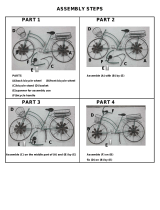
15
Cautions on the use of tubular wheel rim
General Safety Information
WARNING
The Tubular Tire System is used widely in racing bicycles because of its lightweight design and the smooth cornering performance
that it provides. However, a greater level of awareness in handling is required compared to clincher-type tires, and also a greater
degree of care must be taken when carrying out maintenance work. In addition, inspection of the wheels must always be carried
out prior to use.
These precautions must be observed in order for the optimum performance features of this product to be obtained. If these
precautions are not observed, the tires may come off the rims or damage to the tires may occur, and these could result in severe
injury to the rider. Make sure that you read and fully understand the following points on using tubular tires. Furthermore, if you
are not confident that you have enough knowledge and experience in installing and removing the tires or carrying out
maintenance, ask an authorized bicycle dealer or a professional bicycle technician for assistance.
Do not use these tubular tires if you are not confident that they have been installed by someone with an adequate level of
knowledge and experience.
•
A special adhesive designed exclusively for tubular tires is used to secure the tires to the wheel rims. If any other type of adhesive
is used, it might not secure the tires in place with sufficient force, and it may also cause deterioration of the rim material.
•
When cleaning the rim surfaces, use only a cleaning agent which is exclusively designed for tubular tires. If any other type of
cleaning agent is used, it may cause deterioration of the rim material. If using carbon fiber rims, do not rub the surfaces of the
rims vigorously with sandpaper or anything similar, otherwise the carbon fiber layer of the rims may peel off when replacing the
tires.
•
If the adhesive is not applied correctly to the rim surfaces, it may not hold the tires securely in place, and the tires may easily
come off the rims. Particularly when using the rims for the first time, always be sure to clean the rim surfaces thoroughly with the
correct cleaning agent to remove any traces of grease and other foreign materials. Then apply a thin layer of adhesive to the rim
surface to create a secure bonding between the adhesive and the rim surface. When this has been done, apply more adhesive
evenly to the rim at a thickness which is just sufficient to cover the roughness of the tire and no more, and then install the tire.
When using rims which contain carbon fiber material, if the tires are not attached properly, or if the wrong type of adhesive or
cleaning agent is used, it may not be possible to obtain the same degree of adhesion force between the rim and the tire as for
aluminum rims, and it may also cause a reduction in the strength of the carbon fiber rims.
•
Depending on the type of adhesive used, there may be large differences in factors such as adhesion force, the time taken for
correct adhesion to be obtained, the durability of the adhesive bond and the sensitivity to conditions such as temperature and
humidity. Therefore, you should pay particular attention to the adhesion force when using the wheels.
•
You should always check the tires each time before use, by applying a force to the tires to make sure that they are properly
attached to the rims.
•
The adhesion force of the tires may deteriorate after long periods of use, and so you should re-apply the adhesive at periodic
intervals. If using carbon fiber rims, use a rim cement cleaner or similar when replacing the tires to assist in peeling the tires off
gently in order to avoid pulling away the carbon fiber layer.
•
If you do not apply any adhesive to the adhesion surface of the tire when installing the tire to the rim, the adhesion force
between the tire and the rim will be weaker. If you want the tires to adhere to the rims with greater force -- such as when riding
in criterium competition races and track races where hard cornering and acceleration are required -- the tires can be made to
adhere more firmly to the rims if the tires are also coated with adhesive.
•
If the rims become hot as a result of continuous use of the brakes when riding down long declines, sudden loss of tire adhesion
force may occur. If you think that this might happen at some stage, pay particular attention to factors such as selection of the
adhesive and the need to re-apply the adhesive at some stage. Loss of adhesion force can still occur even if measures are taken to
prevent it, so if it still occurs, replace the wheels and discontinue using the tubular type of tires.
•
Check the tires also before use. If there are large cracks in the tires, they may burst during use, and so they should be replaced
beforehand. In addition, the seam covers may come off the tires after long periods of use, and so check the tires before use.
•
If you feel that there are any malfunctions or problems with the system, stop riding the bicycle and contact an authorized bicycle
dealer or a professional bicycle technician for advice.
•
For any questions regarding methods of installation, adjustment, maintenance or operation, please contact an authorized bicycle
dealer.
NOTE
•
If any glue gets on the painting surface of the rim, use a cloth to wipe it off before it dries. Do not use cleaning solvents or
chemicals such as rim cement removers, as they may remove the paint.
















